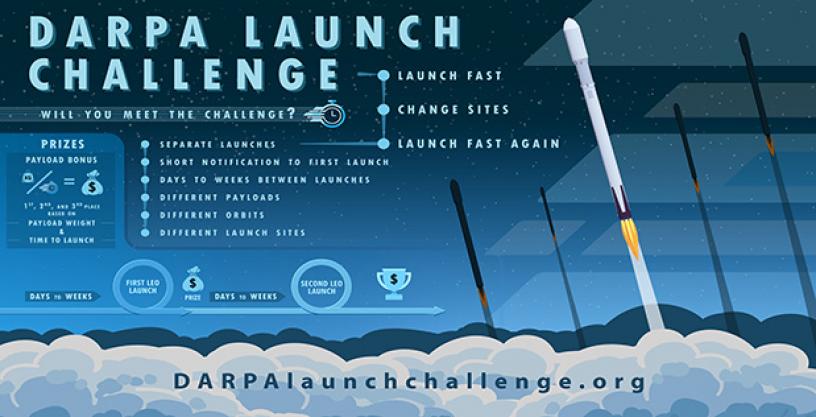
Ideas sought for payloads as DARPA Launch Challenge aims to boost emerging industry of small launch providers
Jul 12, 2018
To maximize use of launch vehicle performance during its 2019 Launch Challenge, DARPA has released a request for information (RFI) seeking payload ideas from the space community. It is anticipated that Launch Challenge competitors will have a wide range of low Earth orbit (LEO) mass delivery capabilities, from roughly 10 to 500 kilograms.
“Today, there is a backlog of payloads to be put into orbit. This RFI is a call for potential payloads that will provide a mutually beneficial arrangement for both the spacecraft developers seeking launch services and the Launch Challenge competitors,” said DARPA program manager, Todd Master. “The DARPA Launch Challenge provides a vehicle to connect these groups and get payloads on orbit in the next 18 months.”
The goal of the DARPA Launch Challenge is to incentivize the emerging industry of small launch providers, which will be able to launch payloads to low Earth orbit while demonstrating capabilities that are both flexible (launch from anywhere) and responsive (launch at any time). The DARPA Launch Challenge seeks to demonstrate new and groundbreaking capabilities to address emerging Department of Defense needs.
Payloads could range from instrumented mass simulators to fully functional spacecraft, as well as on-orbit delivery of payloads that consist of multiple quantities of small spacecraft (e.g., CubeSat-class) with a single interface or deployer to the launch vehicle. Other key information of interest includes:
- Traceability to useful commercial or military missions;
- Desired orbits for operations in low Earth orbit;
- Mission performance from a wide range of orbits (altitudes and inclination); and
- Robustness to a range of launch vehicle environmental conditions.
“In addition to a potential prize from DARPA, we see that that a partial or full launch cost reimbursement to the launch service provider – the competitor – upon successful delivery to orbit also would become part an incentive,” said Master.
The payload provider would provide the hardware directly to the launch vehicle competitor, with integration requirements facilitated by DARPA or its contractors. DARPA envisions that the culmination of the Launch Challenge will be two separate launch competitions within weeks of each other from different locations in the United States.
The request for information seeks ideas, methodologies, and approaches solely for information and planning purposes. Responses will be used to determine the availability of potential payloads to use in conjunction with the DARPA Launch Challenge. For additional information about the DARPA Launch Challenge, visit www.darpalaunchchallenge.org.
Responses to the RFI should be sent to LaunchChallenge@darpa.mil, and are due Friday, July 27, 2018, at 1 p.m. EDT.
# # #
Media with inquiries should contact DARPA Public Affairs at outreach@darpa.mil
Associated images posted on www.darpa.mil and video posted at www.youtube.com/darpatv may be reused according to the terms of the DARPA User Agreement, available here: http://go.usa.gov/cuTXR.
Tweet @darpa
